Three-Dimensional Electro-Thermal Analysis of a New Type Current Transformer Design for Power Distribution Networks †
Abstract
:1. Introduction
2. Electro-Thermal Coupling Model of New Current Transformer
- Skin effect is not considered for the transformer under the operating environment of power frequency.
- The new current transformer has an internal quasi-stable field, and the influence of displacement current is not considered in the analysis process.
- In the model, the relative dielectric constant and conductivity of different materials are constant.
- The air area inside the transformer is incompressible gas.
2.1. The Coupling Calculation Flow of the Electro-Thermal Coupling Model
2.2. Physical Modeling
q = −k∇T
2.3. Take Meshes
3. Heat Source and the Modes of Heat Transfer
3.1. The Analysis of Heat Generation
3.2. Heat Transfer Analysis of CT
4. Results and Analysis
4.1. The Temperature Field Distribution Characteristics with Different Current
4.2. The Characteristics of Temperature Distribution Field Under Different External Ambient Temperature
4.3. Distribution Characteristics of Temperature Field Under Different Core Diameter Guide Rod
5. Conclusions
- The temperature distribution of the main heat source guide rod of the new current transformer is in a “parabola” form. The hot temperature and the maximum temperature gradient of the transformer change linearly under different current.
- Under different external ambient temperatures, the overall maximum overheating of the transformer remains unchanged between 40 and 41 K. Although the maximum temperature gradient decreases gradually with the increase of external ambient temperature, the decline can be ignored. Due to the uneven distribution of temperature, water molecules in the internal may migrate and form condensation, which will harm the safe operation of the current transformer.
- For the guide rod, which is the main heat source of the transformer, in the case of different core diameters, its hot spot temperature and maximum temperature gradient decrease with the increase of core diameter. Among them, the maximum temperature gradient decreases exponentially with the increase of core diameter, and the rate of change tends to saturation at 18–20 mm. At this point the core diameter size is the most reasonable.
Author Contributions
Funding
Data Availability Statement
Conflicts of Interest
References
- Guo, L.; Yu, Z.; Bo, L.; Tao, D.; Yongyi, Z. Optimal design of insulation of current transformers cast by epoxy resin at high altitude. High Volt. Electr. Appl. 2010, 46, 57–60. [Google Scholar]
- Yu, G.; Dong, B.; Zhang, Z.; Xiang, N.; Bin, D.; Zhu, Z. Simulation calculation and analysis on three-dimensional electro-thermal coupling of a new type of current transformer for distribution network. In Proceedings of the 2020 IEEE International Conference on High Voltage Engineering and Application (ICHVE), Beijing, China, 6–10 September 2020; pp. 1–4. [Google Scholar]
- Shling, Z.; Zongren, P.; Peng, L.; Wei, H.; Haoran, W. The electrothermal coupling model is applied to the calculation of radial temperature and electric field distribution of high voltage dry DC bushing. Chin. J. Electr. Eng. 2013, 22, 191–200. [Google Scholar]
- Shiling, Z.; Yongsheng, H.; Naiyi, L.; Zongren, P. Finite element simulation analysis of SF6 gas insulated composite bushing structure for 1100 kV GIS. Insul. Mater. 2019, 52, 50–56. [Google Scholar]
- Pengyuan, L. Study on the Influence of Ambient Temperature Change on SF6 CT Operation Performance and Countermeasures. Ph.D. Thesis, North China Electric Power University, Beijing, China, 2016. [Google Scholar]
- Zhang, S. Evaluation of thermal transient and overload capability of high voltage bushings with ATP. IEEE Trans. Power Deliv. 2009, 24, 1295–1301. [Google Scholar] [CrossRef]
- Ramu, T.S.; Reddy, C.C. On the computation of electric field and temperature distribution in HVDC cable insulation. IEEE Trans. Dielectr. Electr. Insul. 2006, 13, 1236–1244. [Google Scholar]
- Jyothi, N.S.; Ramu, T.S.; Mandlik, M. Temperature distribution in resin impregnated paper insulation for transformer bushing. IEEE Trans. Dielectr. Electr. Insul. 2010, 17, 931–938. [Google Scholar] [CrossRef]
- Rachek, M.; Nait Larbi, S. Magnetic Eddy-Current and Thermal Coupled Models for the Finite-Element Behavior Analysis of Underground Power Cables. IEEE Trans. Magn. 2008, 44, 4739–4746. [Google Scholar] [CrossRef]
- Eslamian, M.; Vahidi, B.; Eslamian, A. Thermal analysis of cast-resin dry-type transformers. Energy Convers. Manag. 2011, 52, 2479–2488. [Google Scholar] [CrossRef]
- Azizian, D.; Bigdeli, M.; Fotuhi-Firuzabad, M. A Dynamic Thermal Based Reliability Model of Cast-Resin Dry-Type Transformers. In Proceedings of the 2010 International Conference on Power System Technology, HangZhou, China, 24–28 October 2010; pp. 1–7. [Google Scholar]
- Jang, S.-M.; Park, H.C.; Cho, S.K.; Lee, S.-H.; Cho, H.W. Thermal Analysis of Induction Heating Roll With Heat Pipes. IEEE Trans. Magn. 2003, 39, 3244–3246. [Google Scholar] [CrossRef]
- Lee, M.; Patel, D.; Abdullah, H.A.; Jofriet, J.C.; Fahrioglu, M. Air temperature effect on thermal models for ventilated dry-type transformers. Electr. Power Syst. Res. 2011, 81, 783–789. [Google Scholar] [CrossRef]
- Xiuguang, L. Finite element analysis of temperature field of SF6 CT. High Volt. Electr. Appl. 2015, 51, 121–124. [Google Scholar]
- lan, X.; Yanlong, Z.; Zikang, Y.; Daojuun, S.; Chaohui, X.; Wei, H. Analysis and calculation of temperature rise of resin cast dry transformer. High Volt. Technol. 2013, 39, 265–271. [Google Scholar]
- Arjona, M.A.; Hernandez, C.; Escarela-Perez, R.; Melgoza, E. Thermal analysis of a dry-type distribution power transformer using FEA. In Proceedings of the 2014 International Conference on Electrical Machines (ICEM), Berlin, Germany, 2–5 September 2014; pp. 2270–2274. [Google Scholar]
- Hui, J.; Hao, W.; Zhiyong, L.; Xin, W.; Peng, Z. Research on the influence of ambient temperature change on SF6 CT operation performance. Power Grid Clean Energy 2017, 33, 65–69. [Google Scholar]
- Ruan, J.; Liu, C.; Gong, R.; Liao, C. Temperature rise of a dry-type transformer with quasi-3D coupled-field method. IET Electr. Power Appl. 2016, 10, 598–603. [Google Scholar]
- Yang, Z.; Naiqiu, S.; Xiaoqing, L. Numerical calculation and analysis of temperature rise of direct-buried gas-insulated transmission lines based on finite element method. J. Wuhan Univ. 2015, 48, 820–825, 830. [Google Scholar]
- Wen, X.; Zhang, J.; Lu, H. Automatic J–A Model Parameter Tuning Algorithm for High Accuracy Inrush Current Simulation. Energies 2017, 10, 480. [Google Scholar] [CrossRef] [Green Version]
- Guojian, L.; Fenghua, W. Calculation and analysis of temperature field distribution of resin cast dry transformer. High Volt. Electr. Appl. 2016, 52, 83–89. [Google Scholar]
- Yongchun, L.; Qiaoling, W.; Caihong, Y.; Jin, Z.; Yanming, L.; Jinyuan, W. Application of three-dimensional finite element method in the calculation of temperature field and carrying capacity of locally buried cable through pipe. High Volt. Technol. 2011, 37, 2911–2917. [Google Scholar]
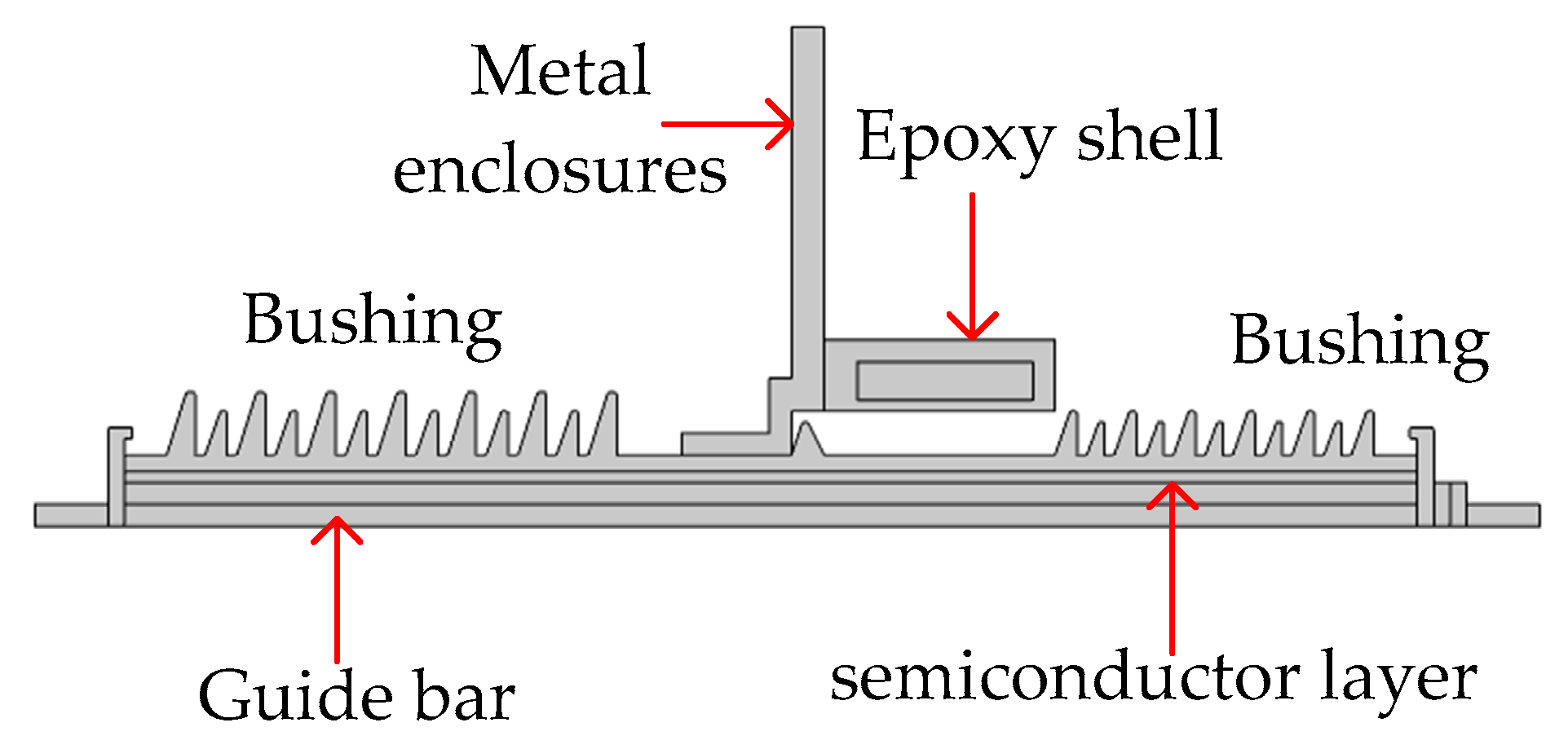
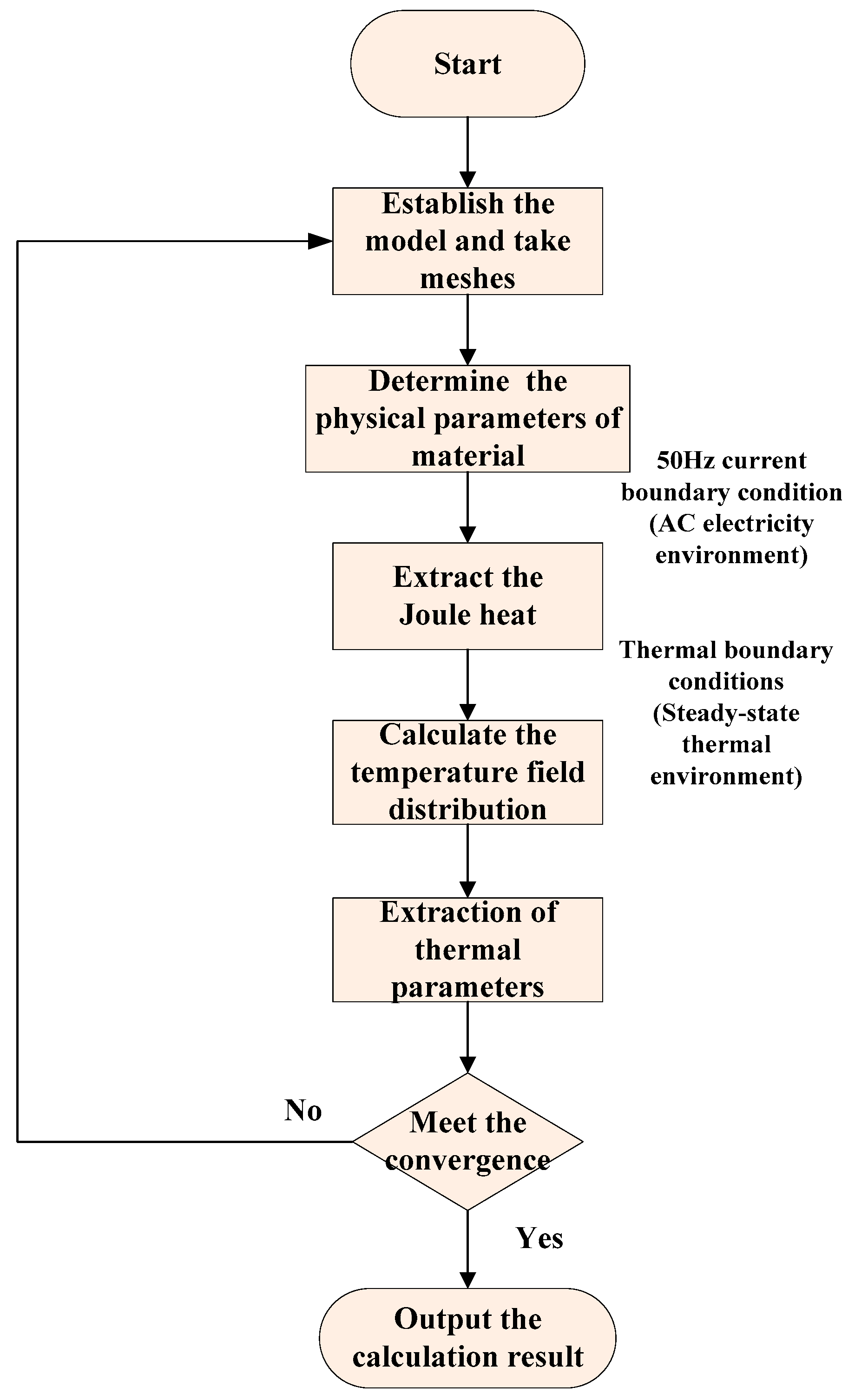
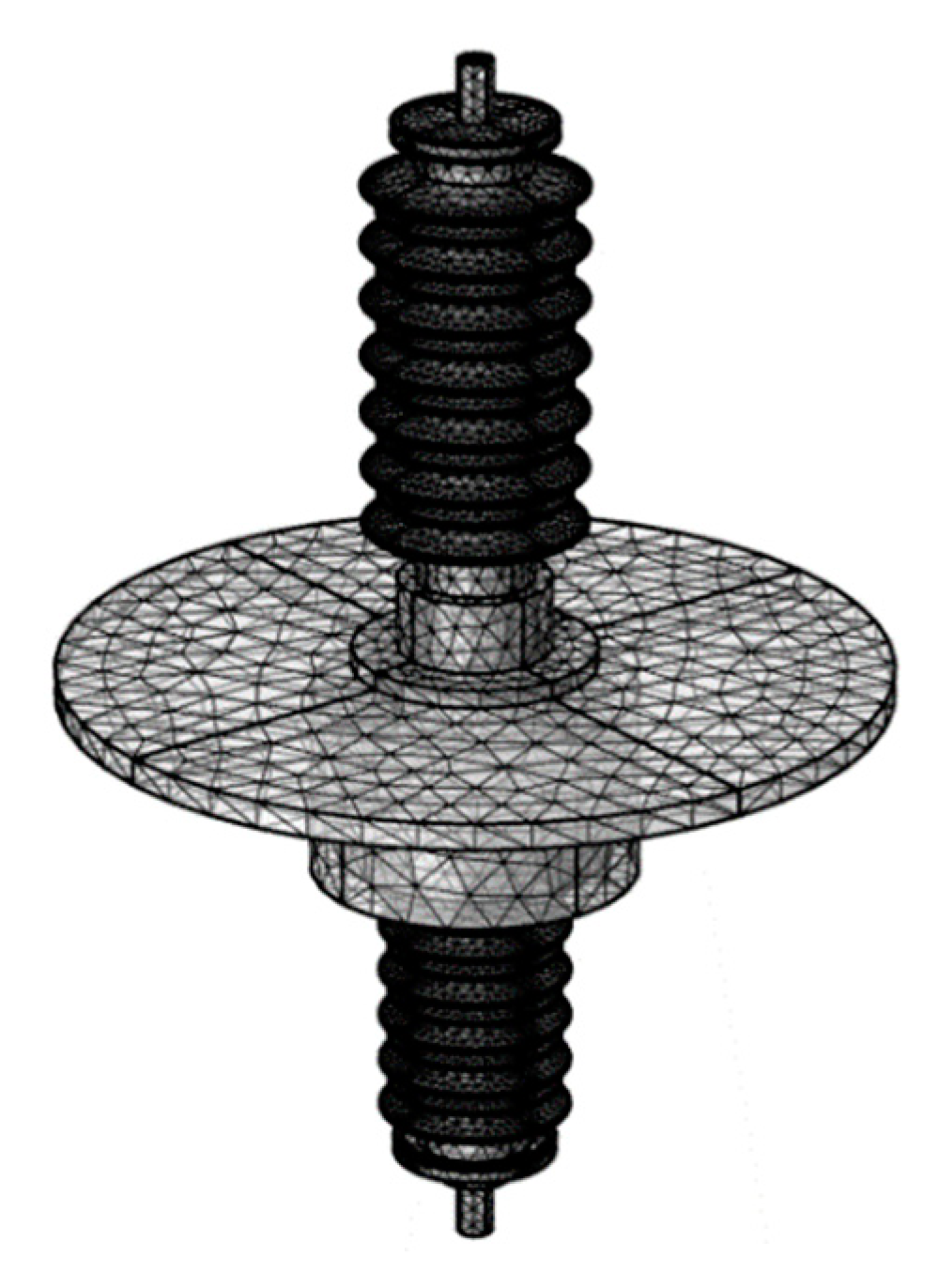
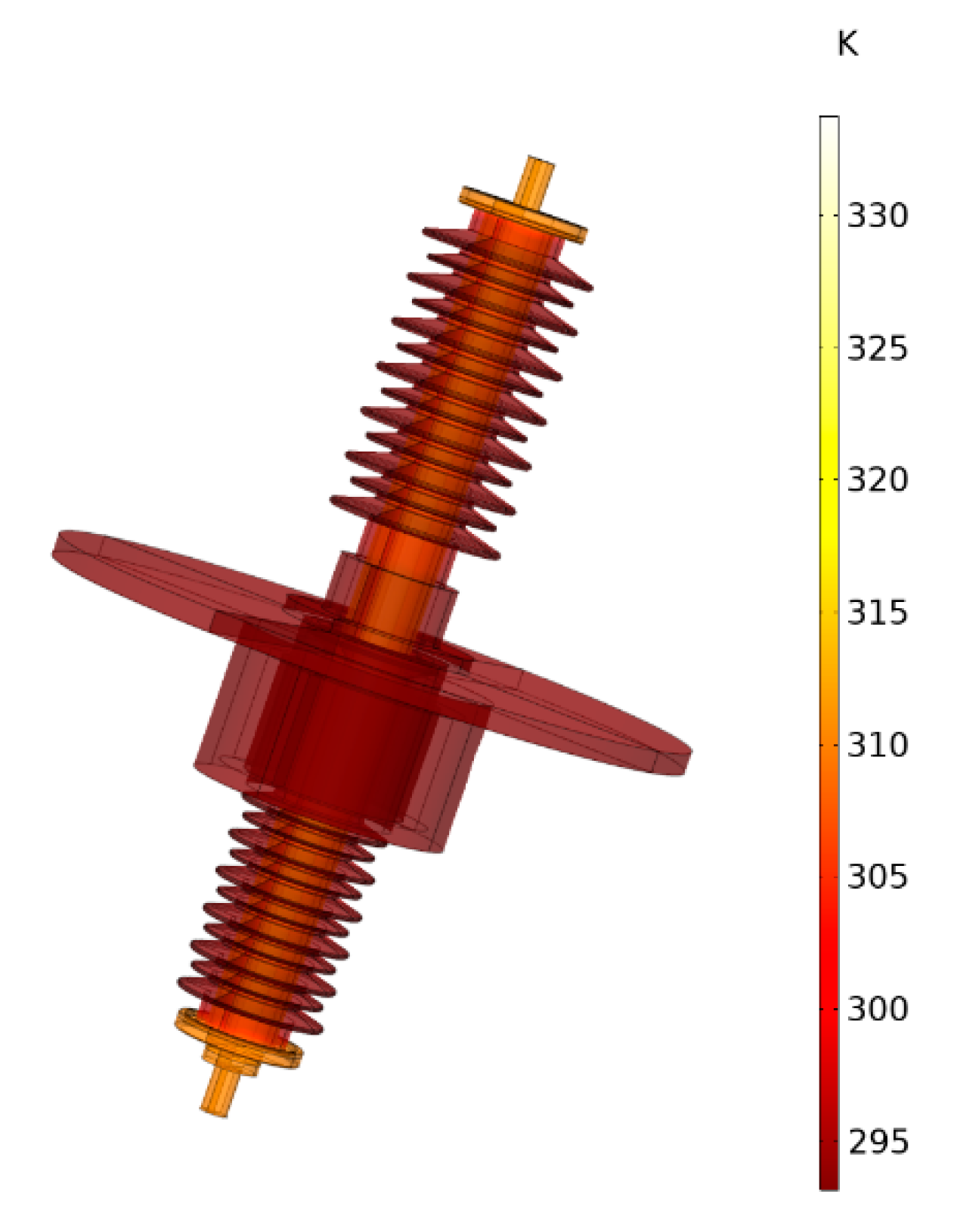
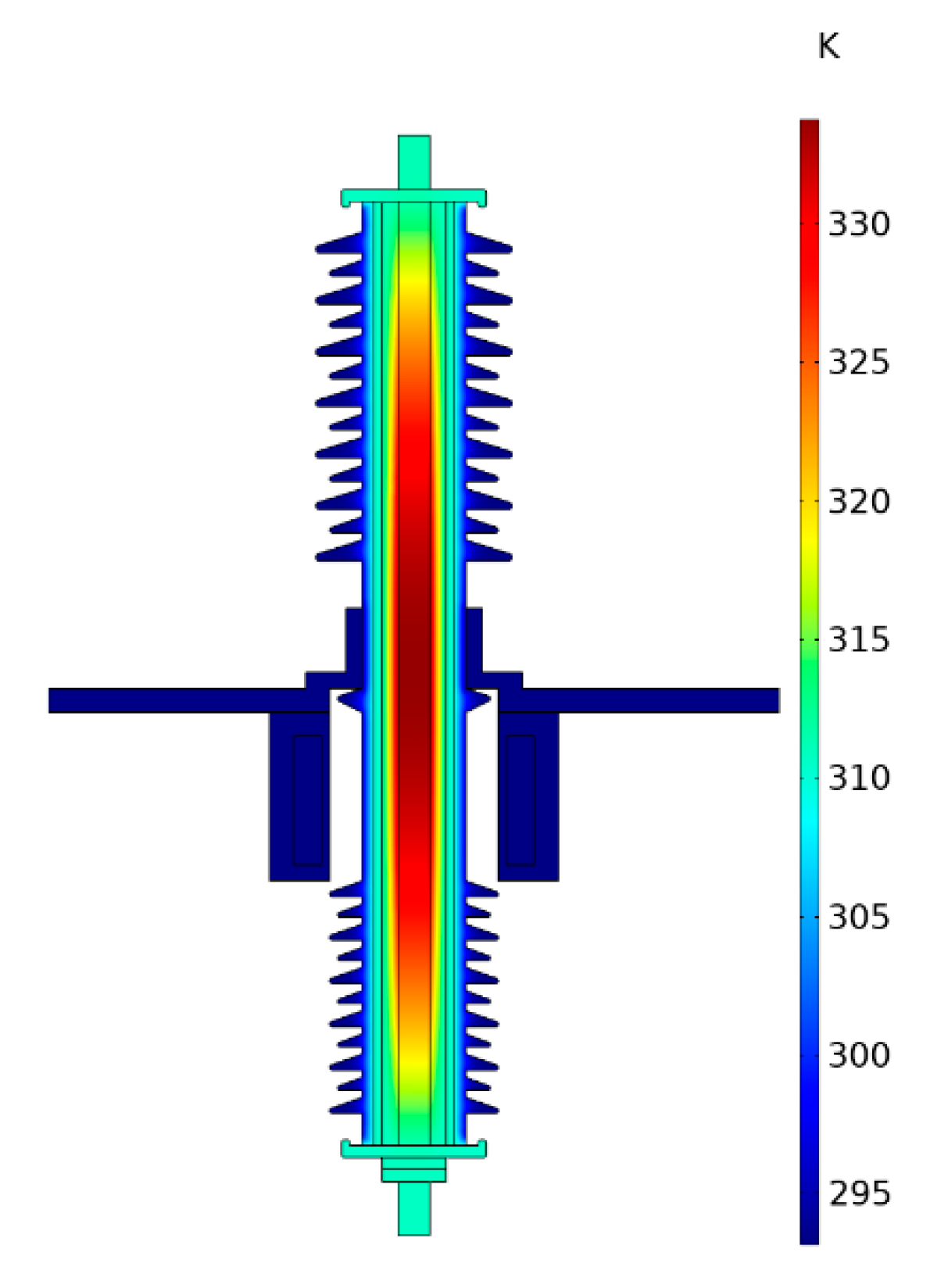




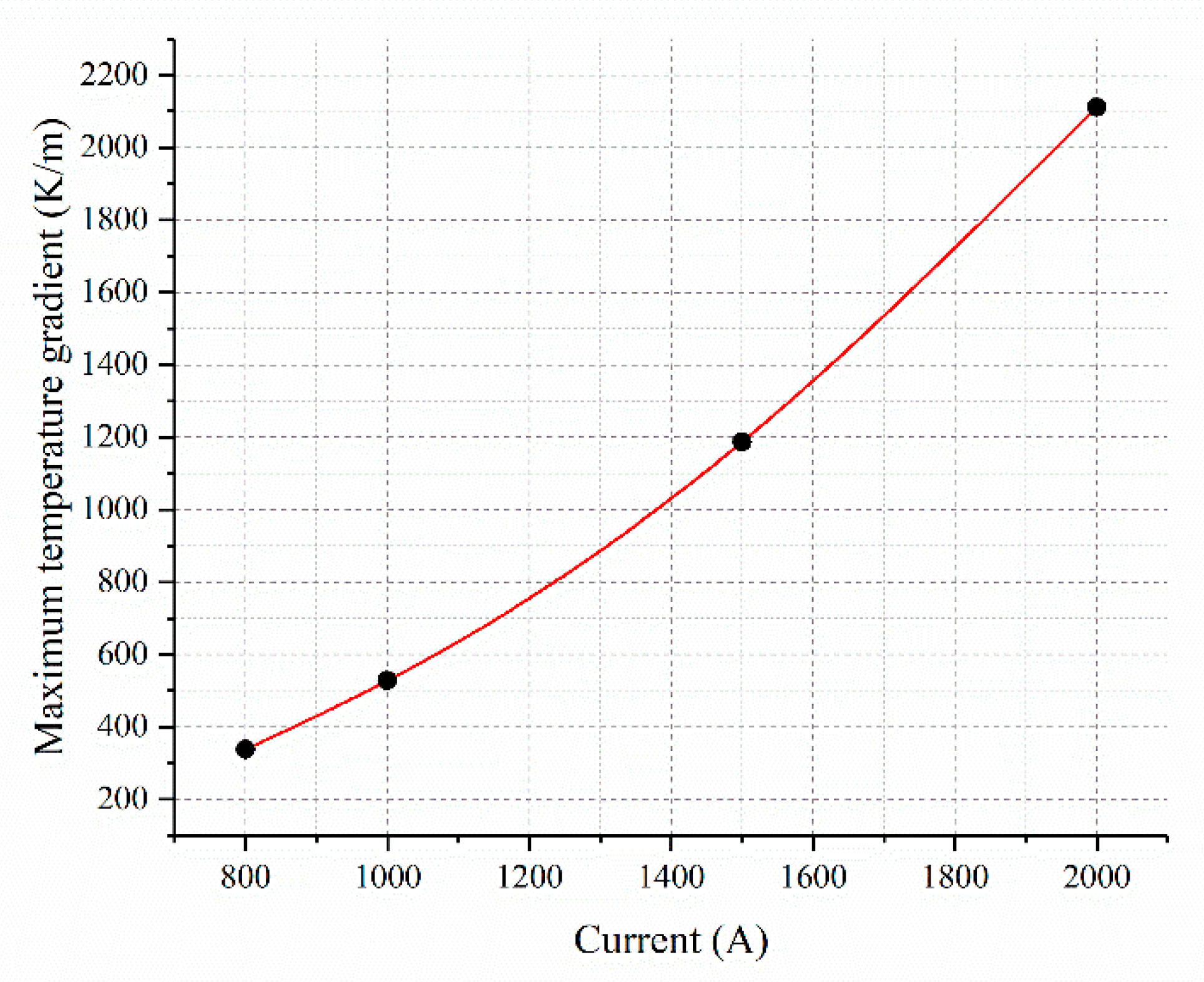

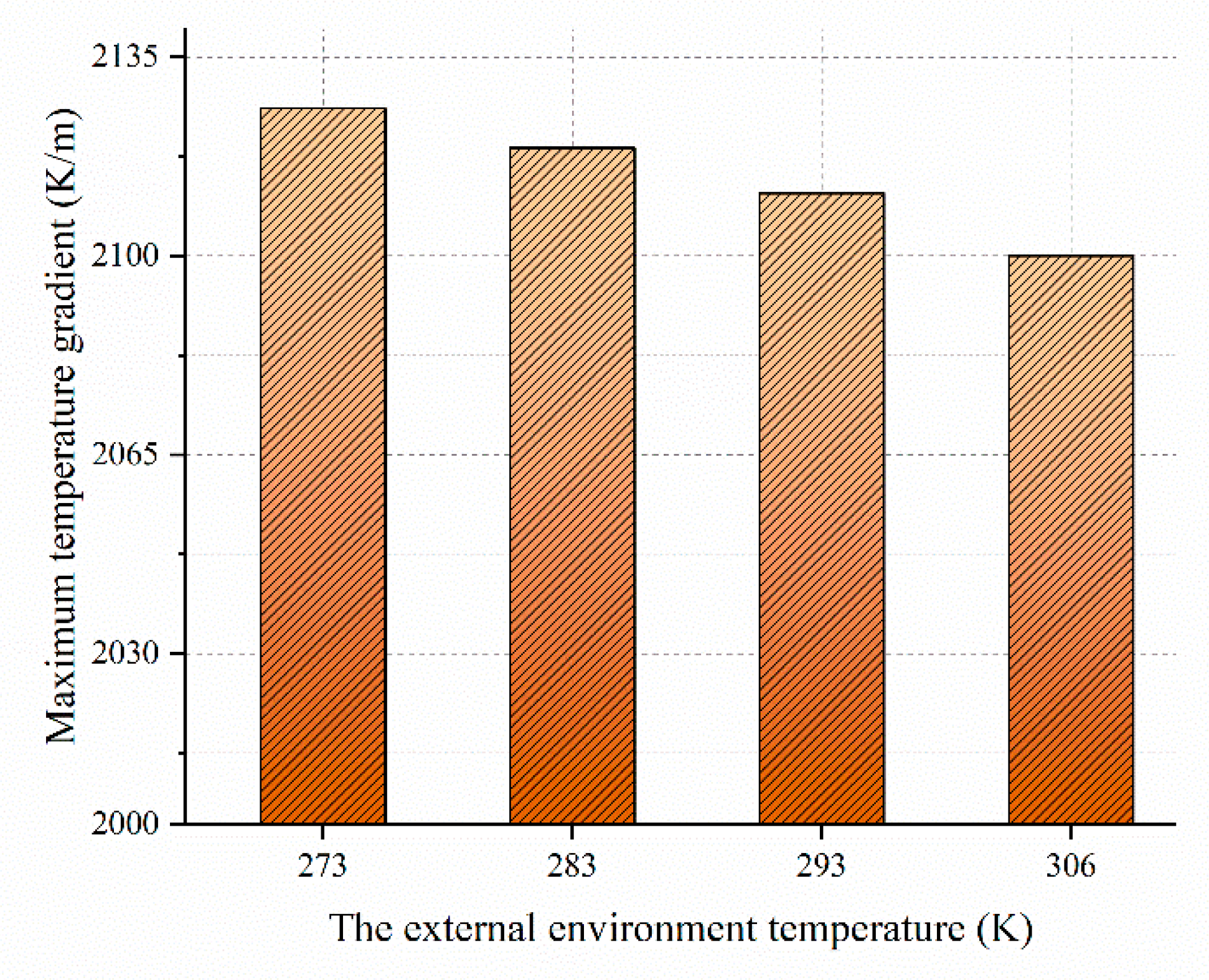

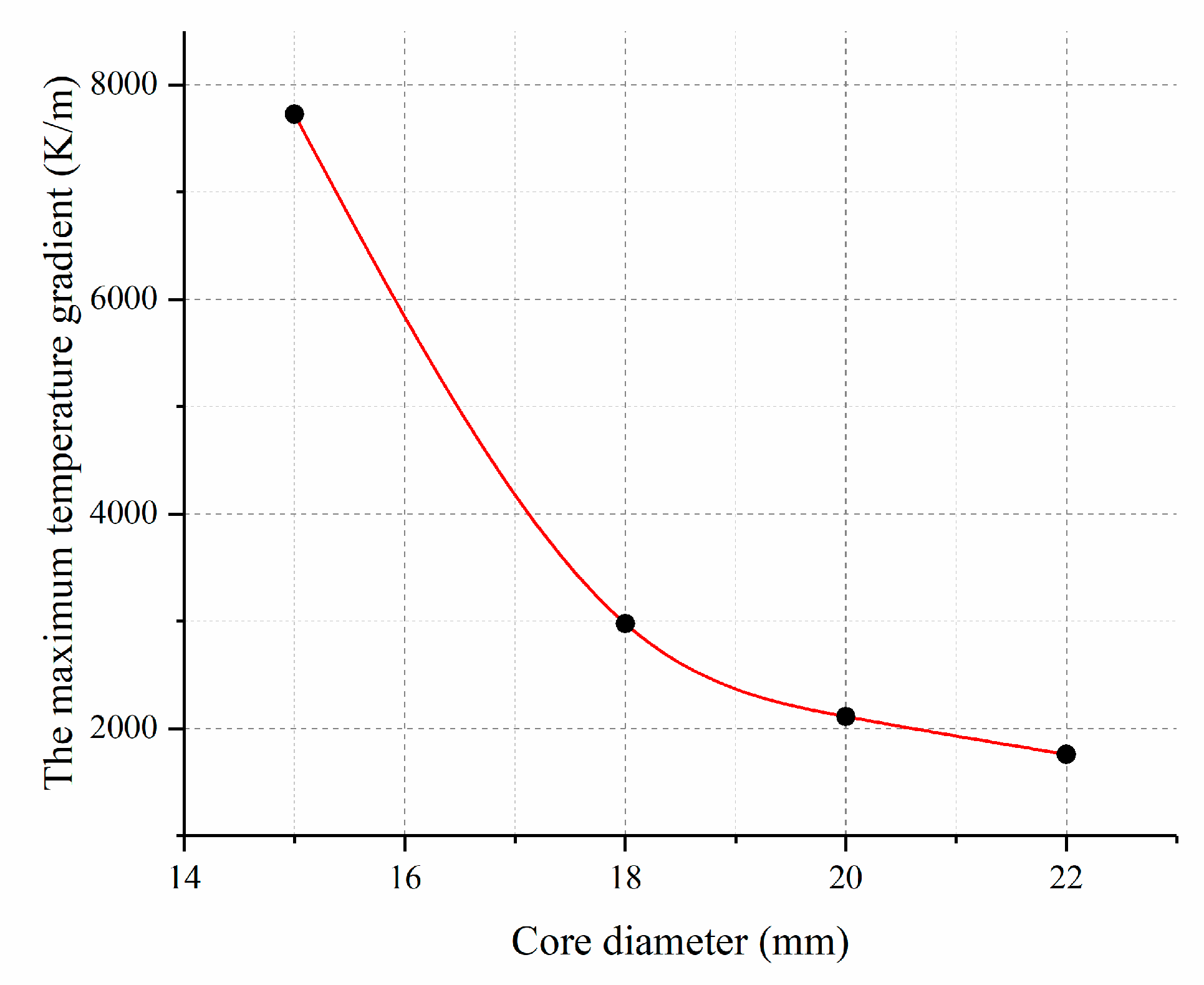
| Parameters | Guide Bar | The Semiconductor Layer | Epoxy Shell | Bushing | Metal Enclosures |
|---|---|---|---|---|---|
| Axial length (mm) | 1177 | 1177 | - | 410 + 290 | - |
| Radial length (mm) | 20 | 10 | 110 | - | 350 |
| Parameters | Material | Conductivity (S/M) | Relative Permittivity | Heat Capacity At Constant Pressure (J/Kg·K) | Density (Kg/M3) | Thermal Conductivity (W/M·K) |
|---|---|---|---|---|---|---|
| Hardware | Copper | 5.998 × 107 | - | 385 | 8700 | 400 |
| Guide rod | Aluminum | 3.774 × 107 | - | 900 | 2700 | 238 |
| Bushing | Ceramic | 1.0 × 10−8 | 5.5 | 426 | 1750 | 0.06 |
| Coil shell | Epoxy-resin | 2.0 × 10−14 | 4.5 | 1400 | 980 | 0.276 |
| The External Environment Temperature (K) | 273 | 283 | 239 | 306 |
|---|---|---|---|---|
| Hot Spot Temperature (K) | 314 | 324 | 334 | 346 |
| Temperature Difference (K) | 41 | 41 | 41 | 40 |
| The External Environment Temperature (K) | 273 | 283 | 239 | 306 |
|---|---|---|---|---|
| Maximum Temperature Gradient (K/M) | 2126 | 2119 | 2111 | 2100 |
Publisher’s Note: MDPI stays neutral with regard to jurisdictional claims in published maps and institutional affiliations. |
© 2021 by the authors. Licensee MDPI, Basel, Switzerland. This article is an open access article distributed under the terms and conditions of the Creative Commons Attribution (CC BY) license (http://creativecommons.org/licenses/by/4.0/).
Share and Cite
Dong, B.; Gu, Y.; Gao, C.; Zhang, Z.; Wen, T.; Li, K. Three-Dimensional Electro-Thermal Analysis of a New Type Current Transformer Design for Power Distribution Networks. Energies 2021, 14, 1792. https://doi.org/10.3390/en14061792
Dong B, Gu Y, Gao C, Zhang Z, Wen T, Li K. Three-Dimensional Electro-Thermal Analysis of a New Type Current Transformer Design for Power Distribution Networks. Energies. 2021; 14(6):1792. https://doi.org/10.3390/en14061792
Chicago/Turabian StyleDong, Bingbing, Yu Gu, Changsheng Gao, Zhu Zhang, Tao Wen, and Kejie Li. 2021. "Three-Dimensional Electro-Thermal Analysis of a New Type Current Transformer Design for Power Distribution Networks" Energies 14, no. 6: 1792. https://doi.org/10.3390/en14061792






